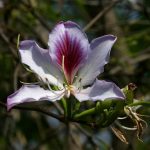TREE LIFE
FEBRUARY 2017
MASHONALAND CALENDAR
Saturday February 4th: National Botanic Gardens Walk. Meet in the car park at 0845 for 0900 hours. This should be an interesting walk after all the rain and we are going to try and find all the trees listed in Kim Damstra’s 1983 article (see below).
Sunday February 19th: Following our successful outing to Henry Hallam Dam in July last year, we are re-visiting this area in the wet season. Mary will do a recce there just before the 19th to assess the conditions and so, unless you hear to the contrary, we will be going there on the 19th. Bring the usual chair, lunch, drinks, suncream, hat etc. Meet at Mukuvisi car park at 9am for a 9.15am start if you want to travel in convoy or share lifts.
Saturday February 25th: Outing to Bruce Cowley and Zia Thomas’s property in Sentosa. Meet at 1415 for a 1430 start.
PLANTED TREES OF HARARE Peruvian Pepper Tree
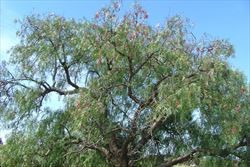
Schinus molle. Photo: Sheldon Navie
Schinus molle belongs to the mango family, Anacardiaceae, and is native to the arid zone of northern South America and Peru’s Andean deserts. It is also found in Central Argentina and Central Chile, through to the Peruvian Andes. There are many common names for this tree including Peruvian or Californian Pepper Tree, American Pepper, False Pepper and Peruvian Mastic.
This tree has become widely naturalised around the world where it has been planted, including California, and hence the one common name. Schinus molle is a drought tolerant, long-lived, hardy evergreen species that has become a serious invasive weed internationally. In South Africa it has invaded savanna and grasslands as well as becoming naturalised along drainage lines and roadsides in semi-desert.
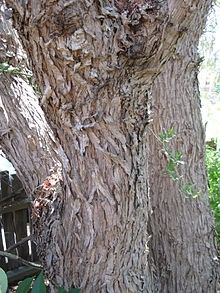
Schinus molle trunk
Schinus molle is a quick-growing evergreen tree with drooping upper branches that grows to 15 metres tall and 5–10 metres wide. It is the largest of all Schinus species and potentially the longest lived. Within Harare, I have not seen this tree grown as a street tree, only in gardens. Unlike the Brazilian pepper tree which has a compact crown, this tree has a sparse crown.
The tree’s twice pinnate leaves measure 8–25 cm long × 4–9 cm wide and are made up of 19-41 small leaflets which can go from being opposite to alternate.
Male and female flowers occur on separate plants. The flowers are small, white and borne profusely in panicles at the ends of the drooping branches. The fruit are 5–7 mm diameter round drupes with woody seeds that turn from green to red, pink or purplish, that are carried in dense clusters of hundreds of berries that can be present year-round. The bark, leaves and berries are aromatic when crushed. The bark is rough, twisted, greyish in colour and drips sap.
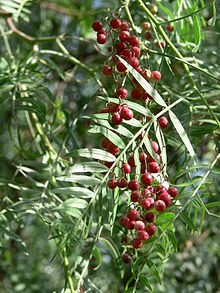
Schinus molle fruit
Like the Brazilian Pepper Tree (Schinus terebinthifolius), the bright pink fruits of Schinus molle are often sold as “pink peppercorns”. The fruits were used extensively in the Central Andes around 550-1000 AD for producing a fermented alcoholic beverage. Extracts of S. molle have been used as a flavour in drinks and syrups. The fruit and leaves are, however, potentially poisonous to poultry and pigs. There are also cases of young children who have experienced vomiting and diarrhoea after eating the fruit.
In traditional medicine, S. molle was used in treating a variety of wounds and infections due to its antibacterial and antiseptic properties. It has also been used as an antidepressant and diuretic and for toothache, rheumatism and menstrual disorders, with recent studies in mice providing possible support for its antidepressant effects. It has also been speculated that S. molle’s insecticidal properties make it a good candidate for use as an alternative to synthetic chemicals in pest control. The leaves are also used for the natural dyeing of textiles in the Andean region. The Incas used the oil from its leaves in early mummification practices to preserve and embalm their dead. It is also known for its strong wood and was part of the Spanish colonies’ supply sources for saddles.
The tree reproduces through seed, suckers and cuttings. The seeds have a particularly hard coat and germination rates are greatly improved after they have passed through birds or animals.
-Tony Alegria Sources: Wikipedia:
OUTING TO CHRISTON BANK BOTANICAL RESERVE, Sunday 15th January 2017
On the Saturday night there were widespread and very heavy rains and there was still a lot of rain around on Sunday morning. However, it was not raining when six of us met in the beautiful Botanical Reserve. Everything was very attractive with the huge, wet rocks and all the trees in full leaf.
Tony led the party and was determined that we were all going to learn something and remember it! As we got out of the cars, we checked a small tree that looked rather like a species of Eucalyptus but it was Faurea saligna of the Protea family. Then we compared the leaves of the two species of Mahobohobo – Uapaca kirkiana with the very large leaves and Uapaca nitida with much smaller leaves but apparently the fruit of both trees is very similar.
We saw several specimens of Turraea nilotica and learned to recognise them by the leaves which appear to be gathered up the main vein. Also easily recognised by their opposite leaves and large thorns was Catunaregam taylorii.
Tony knew he had made a correct identification when we were asked to smell the leaves of Clerodendrum eriophyllum (ex glabrum) and they smelt awful! We admired the beautiful Mountain Acacias, Brachystegia tamarindoides (ex glaucescens) and agreed that they did resemble the Tamarind tree. We could clearly see the fascinating gland at the base of the Monotes glaber leaves, especially when looking through the ‘wrong’ end of binoculars. The many black spots on the leaves of Pavetta schumanniana were also easily seen using the same method.
Other trees seen were: Burkea africana, Combretum molle, Commiphora africana, Flacourtia indica, Lannea discolor, Margaritaria discoidea, Maytenus senegalensis (now Gymnosporia senegalensis), Ochna schweinfurthiana (lovely name!), Ozoroa reticulata, Parinari curatellifolia, Pouzolzia mixta, Pseudolachnostylis maprouneifolia, Psorospermum febrifugum (Christmas berry), Pterocarpus rotundifolius (with its large terminal leaf), Rhus longipes, a very young Sterculia quinqueloba (with its very large, five lobed leaves) and Zanha africana.
With heavy rain threatening, we headed for the cars where we ate our lunch before returning to Harare. We all had an enjoyable morning and hopefully learnt something new. Thank you Tony!
-Dawn Siemers
A blast from the past
Mary has been re-typing all of the past roneoed copies of Tree Life to put onto the Tree Society website once it has been revamped. Here is an article written 34 years ago by a past resident Kim Damstra, who now lives with his family in Norway. During this month’s Botanic Garden walk on 4th Feb we are going to follow in his footsteps and try to find all the trees he has listed here.
A footnote from MCL reads:
“OK Tree Society members, lets put a spring in our step and a new enthusiasm to our walks – even those in their dotage!’
Ed
BOTANIC GARDEN WALK – JANUARY 1983
Having missed two Albizias on our last Botanic Gardens walk, Dr. Tom Muller decided that the first thing we should do on our walk in January was to rectify the omission. So we made straight for Albizia tanganicensis, paper bark Albizia with its characteristic pale stem peeling cinnamon coloured paper. This had been planted in 1967 and has developed into a very nice sized tree. When not peeling the pale trunk could possibly be confused with those of some of the Commiphoras and Sterculias but it is very white, almost opalescent and very smooth and of course in leaf or fruit totally distinctive. The leaves are bi-pinnate with a gland near the base of the petiole. The leaflets fall into the Albizia medium-sized category, are slightly asymmetric, have small petiolules (leaflet stalks) and are pale green.
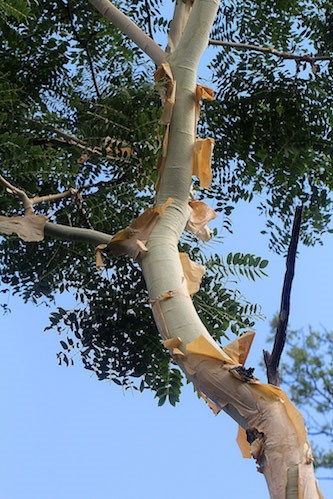
Albizia tanganicencis. Photo B. Wursten, Flora of Zimbabwe.
And I see that the one I picked to look at while writing these notes has a small apical hook, a sharp little point on the under surface of the rachis between the top pair of pinnae.
The flowers are characteristic Albizia flowers, as are the pods, but the pods are not as thickened at the edges as some of the other species.
On our way to find Albizia forbesii we passed Holarrhena pubescens, the Jasmine tree, lovely in white flower. The bark of this species is in great demand for something and the tree has been almost completely ring-barked but it seems to have an internal phloem or bark tissue and be able to continue to exist. It has been treated presumably to help it heal and a notice in Shona is attached warning that parts of the tree may be unsafe to use. Tom speculated as to whether the notice might not be defeating its own purpose and that those with evil intentions might not now be encouraged to collect the bark even more readily. Ficus sycomorus, Sycamore Fig was full of green fruit and Ficus vallis chaudae, with its leaves large enough for the Garden of Eden, was flourishing. Voacanga thouarsii was in full flower which as we passed reminded us of the smell of fresh dough. We did eventually find an Albizia forbesii. Apparently most of them have succumbed to Armellaria, a root fungus associated with land that has been cleared of Msasa. In parts of the Gardens a number of trees have been lost as a result of it. Albizia forbesii, an inhabitant of riverine vegetation on the triassic sands in the south east of the country where it probably gets a bit of winter guti and drizzle, was suffering from lack of water with the drought we have had this year and was only just coming into leaf. It is one of the small-leafleted species.
We then turned our attention to the Terminalias which are members of Combretaceae but which do not have opposite leaves as I had vaguely believed. The leaves are best described as spirally arranged to bunched up or clustered at the ends of the branchlets. The pods are distinctive with a wing all the way round the central portion containing the seed. This only applies to African species, as elsewhere some species produce nuts. Terminalias are also inclined to have branches growing out at right angles to the trunk, giving the tree a layered look rather like the floors of a multi-storey building.
Our introduction to this genus was Terminalia sambesiaca, a riverine species, which occurs in the northern part of the country but is not common. It has a smooth bark, so no adaptation against fires and only loses its leaves in November.
We then looked at the three Terminalia species which occur in medium to low altitudes in hot areas. With them all together for comparison identification was obvious, but I cannot help feeling that by themselves it might not be so easy. So I have listed the points that Tom mentioned and also those I have subsequently dug out of books. Terminalia prunioides, Purple-pod Terminalia has arched drooping branchlets; the branchlets are straight and the hairy leaves are borne on spine-tipped spur shoots. Later, of course, we saw one which was glabrous (without hairs). In purple fruit which are over 4cm long, the largest of the three, this species is very striking. The specific name prunioides means plum like and refers to the colour of the fruit. The flowers are small and star like with an unpleasant smell. In fact on one occasion at Kariba, the scent was so unpleasant that my friends irreverently christened it “Prunus vulgaris”.
Terminalia stuhlmannii, Zig-zag Terminalia, has flat slightly ascending branches with branchlets that zig zag. The leaves which usually are glabrous, have veins prominent on the upper surface and margins tightly rolled under. They are clustered on short lateral spurs which sometimes have spines at their bases.
Terminalia randii – small leaved Terminalia – has the smallest leaves, usually without hairs, without prominent veins and without rolled under margins. In fact it has been described as looking rather like a hawthorn. The leaves are clustered on short woody bosses which occur in the axils of the spines that can be up to 10cm long. Perhaps this should be called the Spiny Terminalia.
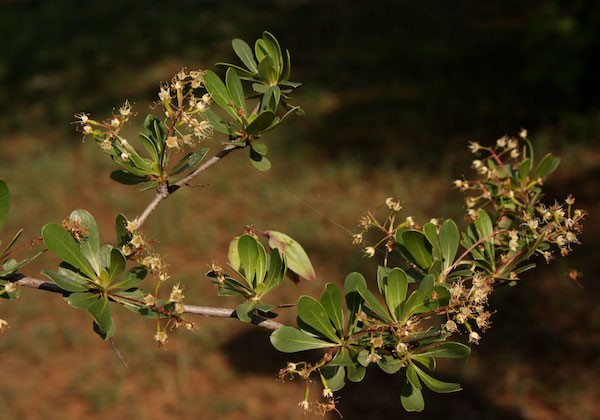
Terminalia randii. Photo: Bart Wursten, Flora of Zimbabwe
We then turned our attention to Terminalia mollis, Large-leaved Terminalia. This has large velvety leaves, (”mollis “ means soft) roundish in shape, spirally arranged around the branchlets and far enough apart to give the impression of being alternate. The branchlets eventually become corky. The fruits, which seldom become more than pink tinged, are the largest of the species. All of which help to separate T. mollis from Terminalia stenostachya, Rosette-leaved Terminalia with its leaves more elongated and pointed, borne in rosettes on pink petioles. When they fall, they leave hollows or leaf scars along the branchlets, which do not peel as do so many Terminalias and Combretums. I should like to emphasise the presence of the leaf scars, the absence of peeling and the pink petioles, as it is only pure T. stenostachya which has these features.
Terminalia trichopoda may be a proper species but it is commonly thought to be a fertile hybrid of T. stenostachya and T. sericea. Terminalia trichopoda does not have leaf scars and does have peeling branchlets and we were able to walk round the Gardens distinguishing between them on those features. The point was raised that while T. trichopoda occurs around Bulawayo, T. stenostachya does not – would that give support to T. trichopoda being its own species after all? Apparently it can happen that the parents of a hybrid become extinct and when that happens we have what is fascinatingly called a phantom hybrid.
Terminalia sericea, Silver Terminalia or Mangwe, has grey leaves with silvery silky hairs and frequently the branches grow at right angles to the trunk, giving it a characteristic layered look. It is a minor component of sand veld but as soon as old lands are left dormant it is one of the first trees to become established. It is very resistant to fire and in fact the seed germinates better after it has been burnt. The Mangwe Pass near Masvingo derives its name from the presence of these trees which the early pioneers believed were the same as the Silver Trees (Leucadendron argenteum) of the Cape Peninsula.
Terminalia gazensis is a forest-edge and dry forest species and as such is slightly more drought resistant than some of the evergreen forest species. It is irregularly layered and its leaves are a special shade of green that makes one feel cool just looking at it. This is also an early coloniser, this time in cleared forest areas.
Lastly there was Terminalia brachystemma, another species of low altitude hot areas, particularly on Kalahari sand. It is a little like T. sericea but has no hairs and almost no petiole.
I have not mentioned the bark as a distinguishing feature as they are all very similarly “longitudinally fissured”. The galls are also common to several species and the name Terminalia comes from the fact that the leaves are usually terminal, i.e. borne at the end of the branches.
Thank you Tom for opening our eyes to their differences. Previously we have tended to ignore those we do not know and I trust that will no longer be the case.
-Kim Damstra
PS – note from MCL for Bruce Cowley: when we were at Paradise Pools, on Arcadia Dam, last year with the Aloe and Cactus Society we came across a very attractive “papery” tree which no one could identify, and there were many of them. I then asked Meg Coates Palgrave and she identified it as Albizia tanganicensis, Paper Bark Albizia, with its characteristic pale stem peeling cinnamon-coloured paper.
TONY ALEGRIA CHAIRMAN



